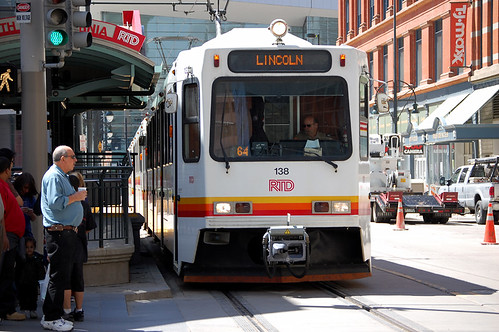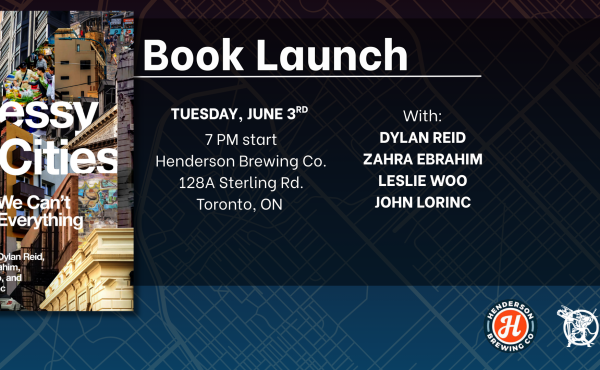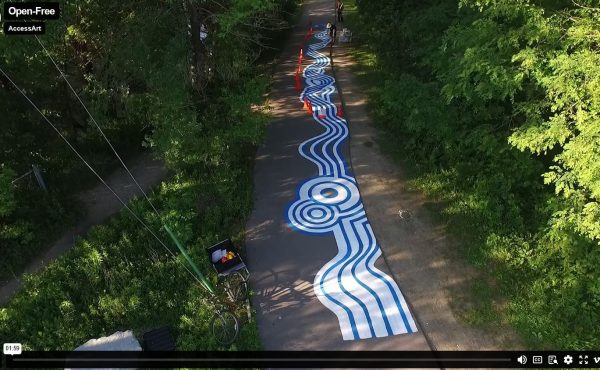
DENVER, COLORADO — After viewing one of the craziest buildings I have ever seen — the Cadet Chapel of the Air Forces in Colorado Springs — I whipped up I-25 and spent some time in downtown Denver. Like Albuquerque yesterday, I only had about two hours to explore, so I concentrated on the city’s rather impressive 16th Street Mall, a three-kilometre long pedestrian zone.
The mall is in the heart of Denver’s downtown. It’s a great mix of of cafés, restaurants, shops, office buildings, vendors, and public art. While Albuquerque’s pedstrian mall was tame and quiet, Denver’s mall was buzzing with people. The sidewalks and patios were packed and it seemed to be a good mix of tourists, office workers, and locals. What excited me about the mall was that Denver and Toronto share very similar weather, which means that I can shoot down naysayers who argue that Toronto can’t have a significant pedestrian mall because we have four months of snow. I saw trucks with snow plows that were doubling as watering trucks for the trees and planters. What I saw in Denver could very well be the future of a new Yonge Street Mall in Toronto. Dare I dream.
The following photos (22 of ’em) take a look at the urban design and street furniture of the 16th Street Mall.


Calling the 16th Street Mall a pedestrian zone is slightly misleading since those on foot share the road space with a number of hybrid buses that run in dedicated lanes (above images). The buses are free and run the entire length of the mall. The lanes have a curb on the “sidewalk” edge but are smooth on the middle part. The materials used for the pedestrian areas and bus lanes are the same, which gives you the impression that one form of transport is no more significant than the other. Buses nearly rub up against you if you are not paying attention (like the man in the photo directly below who yelled at the driver for being clipped on the shoulder).


Besides being hybrid electric, I really liked that buses had three exits/entrances. Its easy for Denver to do this since the bus ride is free, but the TTC should take note of these babies — loading and unloading times could be seriously decreased with this kind of a bus (or streetcar for that matter).


[ click on above image to see larger version ]
What was also nice to see were the LRT trains that cut through perpendicularly to the mall (above images). Each had their own dedicated lane — eastbound was on Lincoln Street, while westbound passengers got on at California Street about 200 feet away. Intersecting with the pedestrian mall is important, I suspect: the dedicated lines show people that mass transit can move fast and frequently, and there are more eyeballs on the 16th Street Mall than anywhere else in the city at any given time. The nicely designed and full accessible LRT stops fit in well on the periphery. Again, I hope the TTC takes note of these stops as they plan for Transit City: the shelters are attractive and could easily fit into the streetscape of the suburbs.


The median that separates the bus lanes have vendors…




… seats, chairs, artful benches…


… chess tables, each of them unique, and used as a table for lunch…

… info pillars that are ad-free and easy to identify and actullay dispense maps…

… trash bins that fit it nicely (and, again, are ad-free)…


… and a series of planters that gave the area some vibrant colour.


Also of note were the bike racks, common trash bins…

… and their very own version of our moose: bull cows.
BACKGROUND ON MY TRIP:
My trip is a “driveaway†for a vacationing snowbird — I’m driving his car back home in exchange for paying my plane fare and gas expenses (read my first post for more info on what a driveaway is). It was arranged by my friend David Smaller and his little organization called Hit The Road. You can join the Facebook group to receive notices of upcoming driveaway opportunities.
all photos by Matthew Blackett





5 comments
I really like all-door loading on Viva in York Region. I punch in a ticket at my leisure at any stop, and then enter through any door. It’s obviously faster, and it also significantly reduces stress on the driver — the driver doesn’t have to worry about fares, and they can concentrate on driving instead of greeting twenty people at every stop.
Brilliant photo essay. I’ve been reading about the 16th St mall for years and have always wanted to see the details. By the way, this mall has been in the news lately as changes are being considered and they have called in ULI to advise:
http://snurl.com/252ni
Here is a great historical overview:
http://snurl.com/252nw
And a look at some current stats (24 sidewalk cafes!):
http://snurl.com/252o2
Could this scheme work along Yonge? Maybe. There are many examples of failed and dead pedestrian malls though so you have to be careful to ensure success. Yonge has the foot traffic, but it is a bit narrow, making street furniture, landscaping and cafe seating harder to fit in. A bus is probably out of the question for Yonge due to the widths and the fact the subway is already lining the route. The current retail mix along Yonge is probably upscale enough now to avoid the strip being a dollar store/low-end retail disaster (as it was in the 1990s) but the element of shady hangers-on is still present.
I would personally favour allowing public vehicles on Yonge to keep the street a public street (with all the ensuing benefits), but perhaps only one lane in both or even one direction, allowing the rest of the street width to be used for trees (please!), much larger sidewalks and street furniture. In other words, I’d take Oxford St over 16th St.
Nice piece Matthew. Let me offer why this ped mall likely works: vehicle traffic is not greatly impeded. The street grid is small–about 150m–with one-way streets on either side. The impact of taking 16th out of this network would have had little effect. Small block street girds can absorb the traffic load better than large block grids.
If we were to try and do this same experiment on Yonge, the streets to the east and west would need to handle the displaced volume before the City would ever accept such a proposition. For comparison, the east west downtown grid in the vicinity of Yonge is about 3 times that of downtown Denver. If you look at a Google map, you’ll see how the surrounding infrastructure allows for this to work so well. I would be greatly suprised if the residents on any of our east-west streets would want to accept the additional vehicles on their street to avoid a ped mall.
Another interesting feature of the LRT in Denver’s downtown is that Lincoln Street and California Street are one-way streets, but he LRT operates on these streets OPPOSITE the direction of automobile traffic. This reserved lane does not require construction of a curb. On both streets, it operates in its right-hand curb lane.
I have heard, though cannot quote actual studies, that this arrangement reduces the occurrances of LRT-automobile accidents, as LRT movements are more easily seen by drivers.
There is a Denver page on the Toronto LRT Information Page at http://lrt.daxack.ca
Found your blog by mistake. You pictures of the 16th St. Mall are great. You should post them on the Downtown Denver Facebook page.
Growing up with BART in the S.F. Bay Area, and then moving to Denver with nothing was hard, so I do enjoy the 16th Street Mall 5 days a week, along with the light rail which is my ride to and from home.
I wish you all the luck for the same success in Toronto.
It’s too bad you were not able to see Pearl Street Mall in Boulder. Only foot traffic and more scenic.